|

from
Khandro Website
The word Naga comes from the
Sanskrit, and nag is still the word for snake,
especially the cobra, in most of the languages of India.
When we
come upon the word in Buddhist writings, it is not always clear
whether the term refers to a cobra, an elephant (perhaps this usage
relates to its snake-like trunk, or the pachyderm’s association with
forest-dwelling peoples of north-eastern India called Nagas,) or
even a mysterious person of nobility.
It is a term used for unseen
beings associated with water and fluid energy, and also with persons
having powerful animal-like qualities or conversely, an impressive
animal with human qualities.
In WW II, learn how
inhabitants of Nagaland came to the
world’s attention.
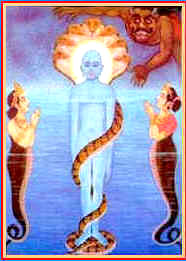 Mythology Mythology
In myths, legends, scripture and folklore, the category naga comprises all kinds of serpentine beings.
Under this rubric
are snakes, usually of the python kind (despite the fact that naga
is usually taken literally to refer to a cobra,) deities of the
primal ocean and of mountain springs; also spirits of earth and the
realm beneath it, and finally, dragons.
In Indian mythology, Nagas are primarily serpent-beings
living under the sea. Here we see the king and queen of water nagas
worshipping Parshva, the Jain Tirthankara of the era
before this one.
All nagas are considered the offspring of the Rishi or sage, Kasyapa,
the son of Marichi. Kashyapa is said to have had by his twelve
wives, other diverse progeny including reptiles, birds, and all
sorts of living beings. They are denizens of the netherworld city
called Bhogavati.
It is believed that
ant-hills mark its entrance.
In Tibetan Buddhism
"Nagas [kLu] are a class of
beings (often snake-like in form) that dwell in a variety of
locations ranging from waterways and underground locations and
also in unseen realms. These beings have their own perceptions
and vary in their enlightened level as do humans and other
beings.
Nagas are susceptible to suffering created by
mankind’s carelessness and basic ignorance of proper conduct in
nature and disrespectful actions in relation to our environment.
Therefore Nagas often retaliate towards humans when they behave
in such ignorant manners.
The expression of the Nagas’
discontent and agitation can be felt as skin diseases, various
calamities and so forth.
Additionally, Nagas can bestow various types of wealth, assure
fertility of crops and the environment as well as decline these
blessings. For this reason the
practice of Lu Sang has
been developed or arises as a natural method to increase
prosperity, and assist the Nagas by preserving the
positive qualities of their natural environment."
~ Tsewang Ngodrup Rinpoche
The bodhisattva Manjushri, in wrathful
form, can appear as Nagaraksha (Tib: jam.pal lu’i drag.po).
Nagas and Water
Water symbolizes primordial
Wisdom and in psychoanalysis, the storehouse that is the unconscious
mind.
However, to paraphrase Sigmund Freud commenting on the
interpretation of symbols in dreams, "Sometimes a cigar is just a
cigar." That is, the water in naga lore is really wet.
In the language of Kashmir, the word for "a spring" is
naga and, in fact, nagas are considered the earliest inhabitants
of that region.
In a sense this is borne out by geology since that
valley was once,
"a vast span of water, similar to a
huge dam, walled in by high mountains. The Nilamatapurana
records how the valley was elevated out of water and left under
the care of the Nagas, of whom Nila, the son of Kashyapa, was
the chief." Kashmir is named after Kashyapa where "the term
‘naga’ stands for spring; ’chesmah,’ and ’negin’ for small
spring.
Springs are the main source of water in Kashmir." And
"the auspicious and famous river of Kashmir, the Vitasta (Jhelum)
originates from a spring near Verinag and is responsible for the
water supply to most parts of the valley.
The religious
significance of the river is established by the Nilamata Purana
[Myth of the Indigo Goddess] when it records the entire land of
Kashmir as the material manifestation of Uma and describes her
as the divine form of the Vitasta."
"A large number of temples were built near springs and were
dedicated to the worship of nagas." and "These places
have become great centers of religious pilgrimage. The place
names of certain areas, e.g. Verinag, Anantnag and Seshanag even
today remind one of the intimate relations between the valley
and the popularity of the Naga cult.
The Rajatarangini of
Kalhana mentions Sushravas and Padma Nagas, who were tutelary
deities connected with the Wular lake. The Dikpalas of Kashmir
are believed to be four nagas, viz. Bindusara in the east,
Srimadaka in the south, Elapatra in the west and Uttarmansa in
the north."
Many Kashmiri festivals
relate to Naga worship, "for example during the first
snowfall, Nila, the Lord of Nagas, is worshipped. The Nagas are
also propitiated in April and are related to Iramanjari Puja and
to Varuna Panchmi, which is organised in July-August."
And "in
the darker half of the month of Jyeshtha, when a big festival is
organised to propitiate the king Taksakyatra. The Nilamatapurana
listed 527 Nagas that were worshipped in Kashmir. In the account
of Abul Fazal, the court historian of Akbar, there are
references to seven hundred places sacred to serpents."
The purana also points to the
association of the cult of Nagas with that of Shiva. In
the Mahabharata and Harivamsa texts, Shesha
was considered the son of Shiva. A lesser relation was
developed with regard to Vishnu as in his sheshashayi form which
links the primal waters with the sleeping Vishnu.
Also, Balarama
who is Krishna’s elder brother is the personification of the
snake, Ananta.
Kashmiri names such as Vishnasar and
Krishnasar are Vaishnavite ones where the suffix sar means ’reservoir.’
Even though Kashmir may be Muslim-dominated in contemporary times, a
spring is "understood as naga and enjoys the respect of every
religion."
"The prosperity goddess, Lakshmi, is
said to have taken the form of the river Visoka (now known as
the Vishov) to purify the people of Kashmir. Most probably,
treating springs and rivers with great reverence wittingly or
unwittingly resulted in the ecological balance necessary for a
healthy and natural interaction between the environment and
man."
" . . . every naga has a snake as its guardian deity.
Fishing is prohibited in these springs, though the fish which
come out of the main garbha [den, lair] of a naga can be caught.
Restrictions on fishing have definitely helped to some extent to
preserve water ecology."
"Hindus still propitiate these nagas. At Martanda Naga even
srada is performed. Water is offered by Hindus to the Sun God
and to their ancestors (purvaj). Before having darshan of the
snow linga at Amarnatha a holy dip is essential in the Seshanaga.
A person suffering from a skin disease is said to be cured after
having a bath in Gandhakanaga (sulphur spring) at Naghbal,
Anantnag."
"Muslims show their respect for
these nagas in many ways. They offer sacrifices and
organize fairs on many festivals such as Id, [e]ven they do not
catch fish in these nagas.
Their faith in nagas can further be
established by an example from Anantnag district, where during
days of water scarcity or extra rainfall, people offer
sacrifices to the Vasuk[i] Naga (the water of which remains in
the valley during summer only and disappears in winter.)
They
have full faith that offerings to Vasuk will bring rain or stop
it as desired."
~ B. Malla, Water Resources and Their Management in
Kashmir
Naga Mythology
Vasuki [also Basuki,] the
naga king, has the gem, Nagamani, on/in his head. It is a universal
panacea [cure-all] and is a bestower of fortune.
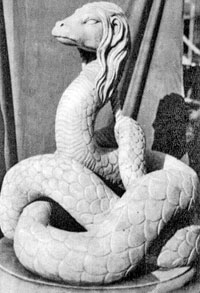
Glycon,
the white naga once worshiped
at Tomis (now in Romania)
on the Black Sea
Manasa Devi, the serpent goddess, is Vasuki’s sister. She is mostly
identified with the cobra, but she can cure any snakebite; indeed,
any adversity.
A popular Indian film shows Manasa coming to visit a
man in his prison cell. She drinks his offering of milk, then
leaves, opening the cell for him on her way out.
Now the maternal naga ancestor, Kadru, once enslaved Vinata, mother
of birds. To ransom her, the Garuda stole amrita, the elixir of
immortality, from the gods. Before the serpents could even have a
taste, Indra stole it back again, however, a few drops of amrita
fell to earth. The serpents slid through it which is why their skin
now has the capacity of renewal.
The grass upon which the nectar fell explains why serpents have
forked tongues. Although they did not get to drink the amrita, the
split in their tongues caused by the sharp-edged dharba [or, durva]
grass provided them a blessing in disguise.
According to Kurt Schwenk, ("Why snakes have forked tongues," Science vol. 263, 1994)
the evolutionary success of advanced snakes is partly due to their
special tongues. The forked tongue allows the snake to
simultaneously sample two points along a chemical gradient, which is
helpful in instantaneous assessment of trail location.
It may also
play a role in mating.
See also,
All About Serpents.
Naga and Fertility
Because of its shape and its association
with renewal, the serpent is a phallic symbol.
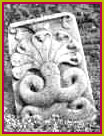
Above is a naga
stone erected in anticipation
or in gratitude for blessings
received

imprint of a
seal found at site of archaic Indus Valley city
This powerful emblem
of fertility is thought to bring plentiful harvests and many
children - images of nagas adorn houses and shrines and temples.
It
is said that when a king once banned snake worship, his kingdom
suffered a drought, but the rains returned once the king himself
placated Vasuki.
Role of the Naga in Buddhism
Nagas are said to have raised their
hoods to protect the Buddha, and other jinas [spiritual victors]
like the Jain saint Parshva.
However, at least 1500 years before
Buddha Shakyamuni’s enlightenment when Ananta or Muchilinda with his
many heads sheltered him, the mythic image of nagas doing homage to
a great yogi was well-known.
|
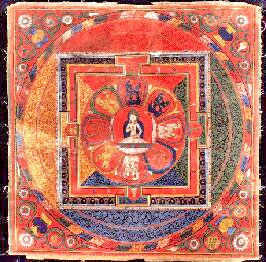
Tangka with
8 great nagas around Vajrapani
. |
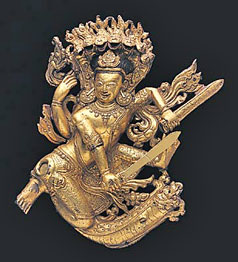
Buddha’s
protector-naga in the process of transforming into
Nagarjuna unsheathing the sword of wisdom |
The Indian mahasiddha Nagarjuna received
his illuminating insights and tantric empowerment with the help of
the nagas in the lake beside which he meditated.
Nagarjuna, as the
champion of Buddhist philosophy is traditionally portrayed with a
sunshade or halo formed by a multi-headed serpent. He is called the
Second Buddha, partly in tribute to his having established the
Madhyamaka [Middle-Way, ie. neither materialist nor nihilist nor
idealist] school of philosophy
As there are serpents in Tibet, and nagas called Lu play a role in
the symbolism of Tibetan Buddhism and in Tibetan mythology, so
Nagarjuna is known as Lu-trub.
The tradition of Sera Monastery holds that when Sakya Yeshe
was on his way back from visiting China, it so happened that the set
of Tangyur (Buddhist scriptures) donated by the emperor fell into
the water while the party was fording a river. The travellers could
see that the texts were hopelessly lost and so, distraught, they
continued on their way back to Sera.
When the caravan finally got back, the monks told them that just
before their return, an old man with attendants had visited Sera and
presented a set of scriptures to the monastery. He said that he was
delivering it for Sakya Yeshe.
It was believed that the old
man was really a Naga king, for when the texts were examined,
it was found that they were still a bit damp.
The traditional life-story [Tibetan: namthar] of Niguma, the
female companion of Naropa, begins during the time of one of
the earliest Buddhas in a region covered by water ruled by a great
Naga King. This Naga was an accomplished and compassionate disciple
of that Buddha and gave his permission for the miraculous drying up
the water for the purpose of erecting a great temple and monastery.
A bustling city grew up around these which acquired a certain
reputation, and came to be called The Land of Great Magic. This is
the place that Niguma was born.
Niguma developed the powerful tantric techniques referred to
as the Five Dharmas of Niguma. The best known is called the
Dream Yoga of Niguma. Her disciple, Naljor, is considered the
head of the Shangpa Kagyu
denomination of Tibetan Buddhism.
Many examples of the naga association with Buddha appear on
the walls and along an avenue leading to the temple of Ankhor Wat
in Kampuchea (formerly, Cambodia) and also in Buddhist temples in
Shri Lanka (formerly, Ceylon.)
See a Thai naga as conceived by S.
Dhumphakdi & Sons Publisher, Bangkok, Thailand (10 Perfections
series.)
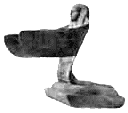 Naga
Figures in Other Traditions Naga
Figures in Other Traditions
A naga with wings may be the iconographic forerunner of the dragon.
It links sky, earth and water. This is Uazet or Wadjet, the ancient
Egyptian wisdom deity who was the protector of pharoahs.
The Creator-goddess of ancient China, Neu-kwa (Nu Kua or Nu
Gua,) is here depicted (below left image)
with only the head of a woman.
However, she is usually described as
having the upper body of a woman that melts into her serpent
lower-half. After creation, during which she made humans, she put
down a rebellion against heavenly order.
When the dying rebel chief
shook the heavenly pillars, she restored the sky by melting
turquoises.
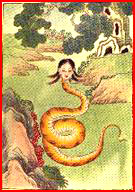
Nu Hua-shi also used the toes of the cosmic tortoise (Kashyapa,
of Indian mythology - below right image)
as markers for the compass’ directions. She restored the land at the
time of the Flood with the ash from burnt reeds.
Since she is
credited with establishing the custom of marriage, she is also
considered the source of human order, (like the Egyptian Ma’at. We
would use the term, Dharma.) The queen of all nagas, she
combines and embodies creativity, cosmic order, water, earth and
sky.
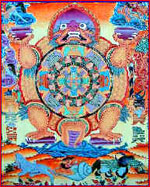
Echidna
(Gr. ekhis, she-viper) of Greek mythology is also often depicted in
this way. She is the mother of the sphinx and other such figures.
The offspring of Sky and Earth, she is sister to the great serpent, Typhon. In Theogony, Hesiod calls her the "Mother of All Monsters."
Another naga-like figure in Greek mythology is Lamia. She was
a daughter of Poseidon who was the queen of Libya. Because Zeus
desired her, Hera killed her children and turned her into a
"monster" having the body of a serpent but the breasts and head of a
woman.
Endlessly obsessing over the image of her dead children, she
could never close her eyes, so Zeus gave her the gift of being able
to take out her eyes and then put them back in.
It is said that
Lamia was envious of other mothers and ate their children.
|

 Mythology
Mythology




 Naga
Figures in Other Traditions
Naga
Figures in Other Traditions
